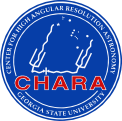Close-Up Images Show How Stars Explode
Astronomers have captured images of two stellar explosions — known as novae — within days of their eruption and in unprecedented detail. The breakthrough provides direct evidence that these explosions are more complex than previously thought, with multiple outflows of material and, in some cases, dramatic delays in the ejection process.
CHARA Array Enters Third Decade of Celestial Discovery
The CHARA Array is marking the 20th anniversary of its first scientific results, published in the July 20, 2005, issue of the Astrophysical Journal.
New View of North Star Reveals Spotted Surface
High-resolution images obtained with Georgia State University’s CHARA Array show large spots on the surface of Polaris.
Study presents most detailed image of inner region of planet forming disks
Remarkable images from the CHARA Array show changing structures in the inner region of a planet-forming disk around the young star V1295 Aquilae.
Finding Cannibalized Stars
Scientists working with the powerful telescopes at the CHARA Array have completed a survey of a group of stars suspected to have devoured most of the gas from orbiting companion stars. These sensitive measurements have directly detected the feeble glow of the cannibalized stars.
A Colossal Star Erupts: Examining One of the Largest Stars in the Milky Way As It Fades From View
Astronomers from Georgia State University’s CHARA Array have captured the first close-up images of a massive star known as RW Cephei that recently experienced a strange fading event.
Dancing with the (Six) Stars: A 200-Year Story of the Castor System
Astronomers study the orbits of a sextuple system — a complex arrangement of six stars in orbit around one another.
Young Planets Around Old Stars? Astronomers Believe Unseen Planets Exist in Empty Space at Center of Dust Disk
Astronomers using the CHARA Array have mapped the orbit of a pair of distant old stars surrounded by a vast disk of gas and dust. Could recently created planets have formed in the disk?
Georgia State’s CHARA Array Detects Elusive, Dusty Inner Region of Distant Galaxy
An international team of astronomers used the CHARA Array to resolve the dusty ring around the supermassive blackhole in the center of a distant galaxy.
The CHARA Array Marks Decadal Milestones
Major recent or in-progress developments include higher-performance visible and infrared beam combiners, and adaptive optics on all telescopes.
The best studied terrestrial planet outside the Solar System
An international scientific team has measured the mass and radius of an Earth-like exoplanet with unprecedented accuracy, allowing them to make predictions about the structure and composition of its interior and atmosphere.
Georgia State Astronomers Offer Theory About Mysterious Location of Massive Stars
Astronomers from Georgia State University have found an explanation for the strange occurrence of massive stars located far from their birthplace in the disk of our Milky Way Galaxy
Searching for Earth 2.0? Zoom in on a star
Astronomers searching for Earth-like planets in other solar systems have made a breakthrough by taking a closer look at the surface of stars.
Searching for Spots with Interferometry
Imaging statspots on the giant star λ Andromedae.
Astronomers at Embry-Riddle Help Unravel Key Mysteries of Rare Stars
The first dynamical mass of a nitrogen-rich Wolf-Rayet star is measured using the CHARA Array to map its visual orbit.
Astronomers Discover a Warped Planet-Forming Disk Torn Apart by Stars
Pioneering new research from an international team of scientists has revealed the first direct evidence that groups of stars can tear apart their planet-forming disk, leaving it warped and with tilted rings.
Pioneering Imager At Georgia State’s CHARA Array Gives Sharpest View Of Stars And Planet-Forming Disks
A pioneering new instrument that can produce the sharpest images of young stars is now available for use by scientists worldwide.
Astronomers Study Variability In Seven Sisters Star Cluster
An international team of astronomers has used a new algorithm to enhance observations from the NASA Kepler Space Telescope in its K2 Mission and perform the most detailed study yet of the variability of the Seven Sisters star cluster.
'Starspot' Images Give Insights into Early Sun
ANN ARBOR—Astronomers at the University of Michigan have taken close-up pictures of a nearby star that show starspots—sunspots outside our solar system.
Astronomers Image the Exploding Fireball Stage of a Nova
MOUNT WILSON, Calif.–Astronomers at Georgia State University’s Center for High Angular Resolution Astronomy (CHARA) have observed the expanding thermonuclear fireball from a nova that erupted in the constellation Delphinus in 2013 with unprecedented clarity.
Astronomers Capture a Rare Stellar Eclipse in Opening Scene of Year-long Show
For the first time, a team of astronomers has imaged the eclipse of the star Epsilon Aurigae by its mysterious, less luminous companion star.
Gazing up at the Man in the Star? Researchers take picture of the face of Altair, a first for a star like our own
Using a suite of four telescopes, astronomers have captured an image of Altair, one of the closest stars to our own and a fixture in the summer sky.
MIRC images of Two Red Supergiants in the OB1 Cluster
MIRC imaged two red supergiants in the Per OB1 association and detected a hotspot on the surface of T Per.



